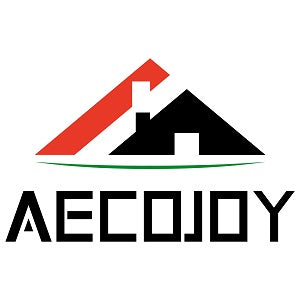A well-installed metal carport can last 15–20 years with minimal maintenance. AECOJOY’s 12x20 model is a popular choice for its galvanized steel roof, rustproof frame, and ability to withstand 100 mph winds and heavy snow. But even the sturdiest metal carports kits won’t perform well without proper installation.
This guide focuses on DIY-friendly steps, but remember: metal carport installation requires teamwork and attention to detail. Rushing through steps or cutting corners can lead to instability, leaks, or damage. By following our instructions, you’ll have a safe, functional metal carport in a weekend.
1. Preparation Before Metal Carport Installation: Tools, Materials, and Site Setup
Preparation is 50% of the job. Taking time to gather tools, prep the site, and prioritize safety will make the installation process faster and smoother.
1.1 Essential Tools and Materials
First, confirm you have all the tools and components from your metal carports kits. AECOJOY’s 12x20 model comes in 3 reinforced cartons (they may arrive separately), so check that nothing is missing before starting.
|
Category |
Essential Items |
|
Tools from the Kit |
Steel frame pipes (1.5”x1.5” thick), galvanized steel roof panels (29 gauge), rain trim, anchor kits, bolts (M4x10mm, M5x16mm, M6x40mm, etc.), nuts, washers |
|
Required DIY Tools |
Adjustable wrench, socket set, drill (with metal bits), level (2–4 ft), measuring tape (25 ft), rubber mallet, work gloves, safety glasses, hard hat |
|
Optional Tools |
Concrete mixer (for anchoring), post hole digger, ladder (6–8 ft), helper clamps |
Pro tip: Lay out all components on a clean tarp and label them (e.g., “left frame,” “roof panel 1”) to avoid confusion during assembly. AECOJOY’s kit includes detailed part labels (like S4, S23, F26) that match the instruction manual—keep the manual handy!
1.2 Choosing and Preparing the Installation Site
Your metal carport’s stability depends on a level, firm site. Follow these steps to prep the area:
- Choose the right location: Pick a spot away from trees, power lines, and underground utilities. Ensure there’s at least 3–5 feet of clearance around the carport for ventilation and maintenance.
- Check for level ground: Use a 4-ft level to test the area. Even a 1-inch slope can cause issues with roof drainage and frame stability.
- Clear and compact the site: Remove grass, rocks, and debris. Use a tamper to compact the soil—this prevents sinking over time. For extra stability (especially in storm-prone areas), lay a gravel base (4–6 inches deep) or pour concrete footings.
- Mark the layout: Use stakes and string to outline the 12x20 ft dimensions of the carport. Double-check measurements to ensure the corners are square (measure diagonally—both distances should be equal).
AECOJOY’s carport is designed for all-weather use, but a well-prepped site will enhance its wind and snow resistance. For areas with frequent storms, concrete anchoring is highly recommended.

1.3 Safety Check and Team Setup
Metal carport installation is not a one-person job. Here’s how to stay safe:
- Assemble a team: You’ll need at least 2–3 helpers. Lifting steel frame pieces and roof panels alone can lead to injury or damage.
- Wear PPE: Always use safety glasses, work gloves, sturdy shoes, and a hard hat. Metal edges are sharp, and roof panels can get hot in direct sunlight.
- Check the weather: Choose a calm, windless day (wind speeds under 10 mph). Avoid installing in rain, snow, or extreme heat.
- Prepare a first-aid kit: Keep it nearby in case of cuts, scrapes, or minor injuries.
- Inspect components: Check for bent pipes, damaged roof panels, or missing bolts. Contact AECOJOY’s customer service if any parts are defective.
2. Step-by-Step Installation Process
Now that you’re prepared, let’s dive into the installation. Follow these steps in order to ensure your metal carport is stable and leak-proof.
2.1 Assemble the Main Frame
The frame is the backbone of your metal carport—take time to ensure it’s level and secure.
- Lay out frame components: Separate the vertical posts, horizontal beams, and cross braces. AECOJOY’s kit includes pre-drilled holes for easier assembly.
- Assemble the side frames: Connect vertical posts (W3, W4, W15) to horizontal beams using M5x16mm bolts (S24). Tighten bolts by hand first—you’ll adjust for level later. Have a helper hold the frame upright while you work.
- Square the frame: Once both side frames are assembled, connect them with cross braces (F23, F26) to form a rectangular structure. Measure diagonally to ensure the frame is square (both measurements should match).
- Level the frame: Use a 4-ft level to check each vertical post. Adjust by adding or removing soil under the posts, or use shims if needed. Tighten all bolts with a wrench once the frame is level.
- Reinforce with cross braces: Install additional cross braces (S23, S31) along the top and sides for extra stability. AECOJOY’s frame is designed to withstand high winds, but proper bracing is key.
Pro tip: If the ground is uneven, use adjustable feet (sold separately) to level the posts. A crooked frame will cause roof panels to fit poorly and leak.
2.2 Install the Roof Panels and Rain Trim
The galvanized steel roof panels are the most important part of your metal carport—they protect against rain, snow, and UV rays.
- Prepare the roof frame: Ensure the top cross beams are level and secure. AECOJOY’s kit includes roof purlins (horizontal supports) to attach the panels to.
- Install roof panels: Start from one end of the carport. Lift the first panel (29 gauge galvanized steel) onto the roof frame, aligning it with the edge. Secure the panel using M6x40mm bolts (S30) through the pre-drilled holes. Space bolts 12–16 inches apart along the purlins.
- Overlap panels correctly: Each subsequent panel should overlap the previous one by 2–3 inches. This prevents water from seeping through gaps. Press panels firmly together before tightening bolts.
- Install rain trim: Attach the rain trim (included in the kit) along the edges of the roof and where panels meet. AECOJOY’s model comes with upgraded high-density rain tape—apply it under the trim to seal gaps and prevent leaks.
- Check for gaps: Walk around the roof (carefully—never step on unsupported areas) and inspect for loose panels or gaps. Tighten any loose bolts and add extra rain tape if needed.
2.3 Anchor the Carport to the Ground
Anchoring is critical for wind resistance. AECOJOY’s metal carport can withstand 100 mph winds, but only if properly anchored.
Choose an anchoring method:
Soil anchoring: Use the included ground stakes (S22, S29) for soft soil. Drive stakes 12–18 inches into the ground at each post base, then secure the frame to the stakes with bolts.
Concrete anchoring: For hard soil or storm-prone areas, dig 12x12-inch holes at each post base. Mix concrete and pour into the holes, then insert the posts (or anchor plates) before the concrete sets. Let concrete cure for 24–48 hours before proceeding.
Secure all anchors
Tighten anchor bolts with a wrench to ensure the frame doesn’t shift. For extra wind resistance, add diagonal anchors from the top corners of the carport to the ground.

3. Final Inspection and Adjustments
Once installation is complete, take 30 minutes to inspect your metal carport—this ensures it’s safe and functional.
- Check stability: Push gently on the frame to test for wobbling. If it moves, tighten loose bolts or add extra anchors.
- Inspect roof panels: Look for gaps, loose bolts, or misaligned panels. Ensure rain trim is properly installed and sealed with rain tape.
- Test drainage: Pour a bucket of water on the roof to check for leaks. Water should run off the sloped roof without pooling.
- Adjust for level: Recheck vertical posts with a level. Make minor adjustments if the frame has shifted during installation.
-
Clean up: Dispose of packaging materials and tools. AECOJOY’s metal carport is now ready to use!

4. FAQs and Practical Tips
Even with careful preparation, you may encounter issues during metal carport installation. Here are answers to common questions:
4.1 What if My Ground Is Uneven?
If the ground has a slight slope (less than 2 inches), use shims or adjustable feet under the vertical posts to level the frame. For steeper slopes, consider grading the area with a shovel and tamper, or build a raised gravel base. Avoid installing the carport on a slope steeper than 3 inches—this will cause roof drainage problems.
4.2 How to Handle Rainwater Drainage?
AECOJOY’s metal carport has a sloped roof designed for drainage, but you can improve it by:
- Ensuring panels are overlapped correctly (2–3 inches).
- Installing rain gutters (sold separately) along the edges of the roof.
- Positioning the carport so water drains away from your home or garage.
4.3 How to Improve Wind Resistance?
To make your metal carport more wind-resistant:
- Use concrete anchoring instead of soil stakes.
- Add extra cross braces along the sides and roof.
- Install diagonal wind braces from the top corners to the ground.
- Trim nearby trees or branches that could fall on the carport during storms.
4.4 Can I Install It Alone?
No—how to assemble a metal carport requires at least 2–3 people. Lifting heavy steel panels (each weighs 20–30 lbs) and holding the frame upright alone is dangerous. A team of 3 is ideal: one to hold components, one to align holes, and one to tighten bolts.

Conclusion: Enjoy Your Durable Metal Carport
Learning how to install a metal carport is a rewarding DIY project that saves money and gives you control over the process. By following these steps, you’ll have a sturdy, leak-proof metal carport that protects your vehicles and gear for years.
AECOJOY’s 12x20 metal carports kits are designed for DIY installation, but don’t hesitate to contact their customer service if you need help. With proper care (regularly cleaning debris from the roof and tightening loose bolts), your metal carport will be a reliable addition to your property.
Happy installing—and enjoy the peace of mind that comes with a protected outdoor space!






















































